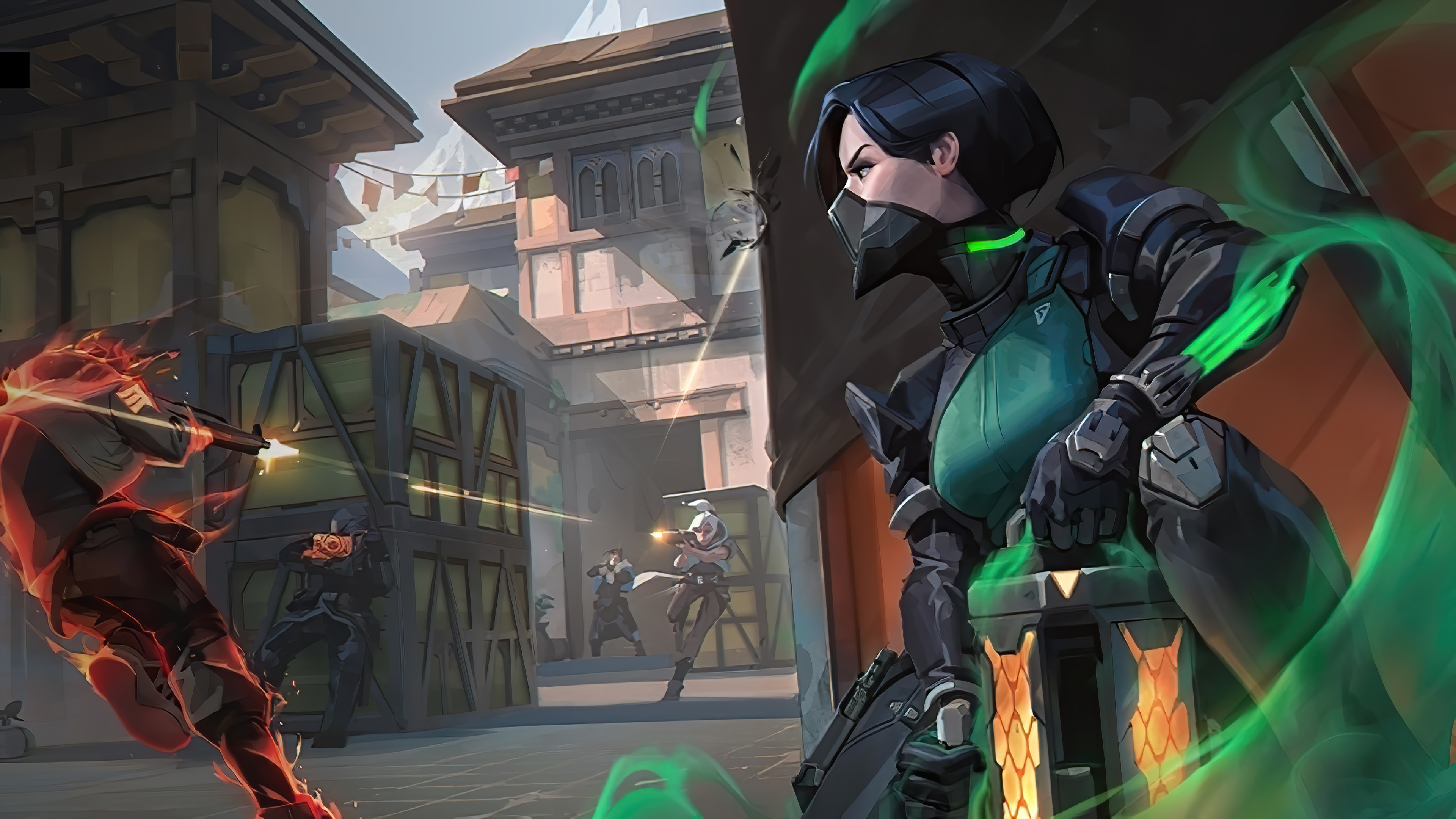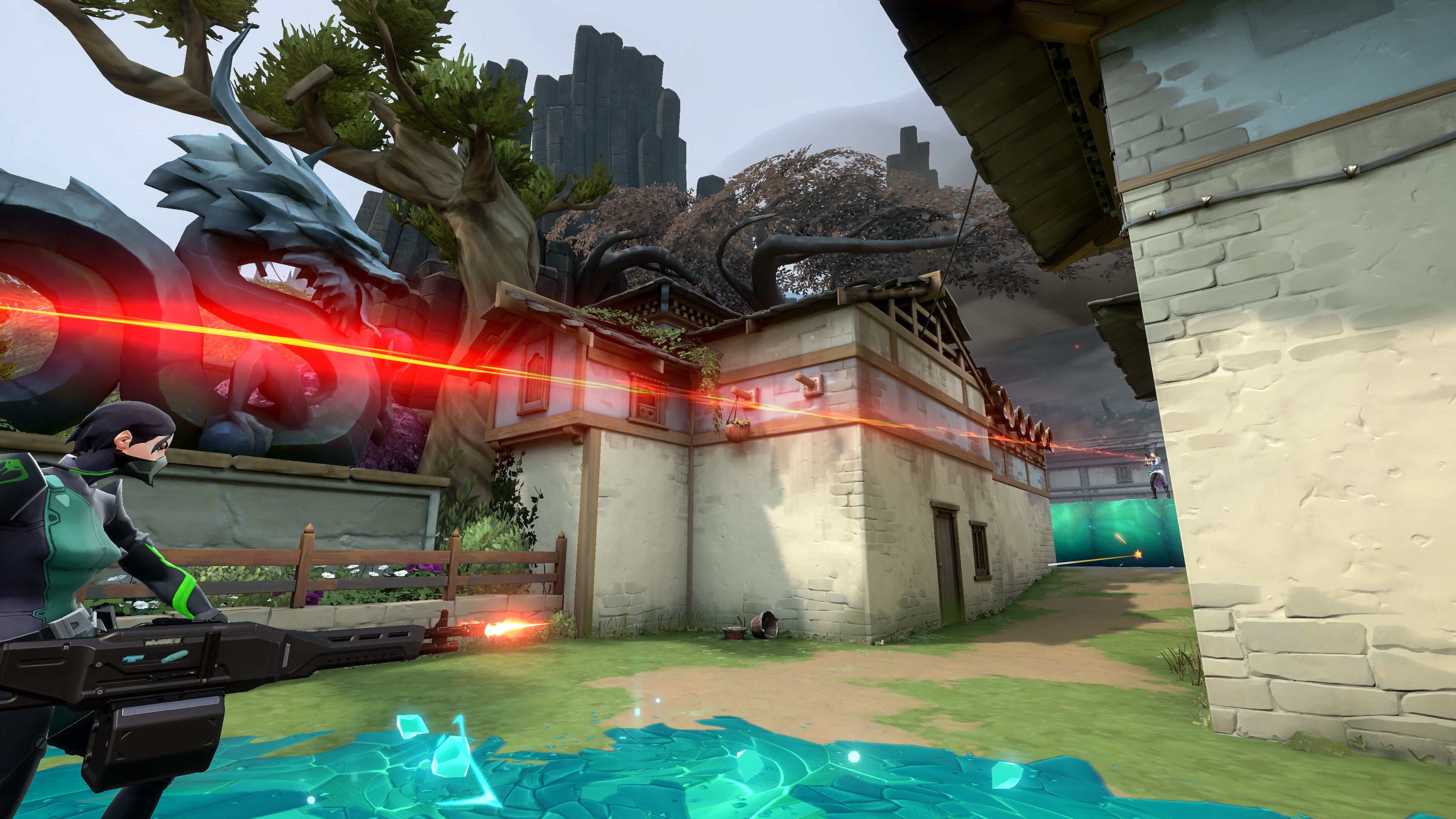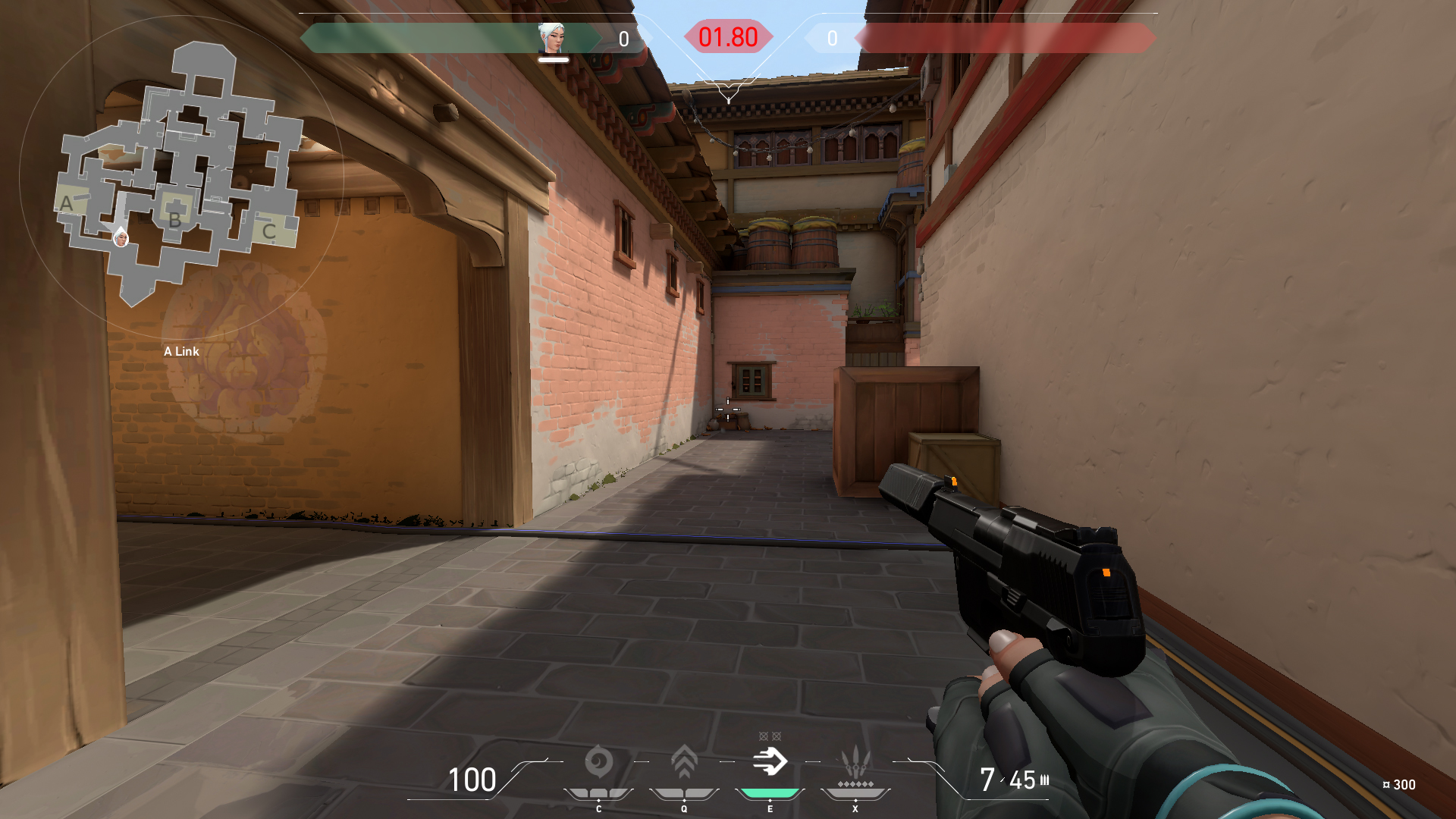Valorant's lead designer on the current meta, Raze's ult, exploits, and map design
How Riot's take on the CS:GO-style tactical shooter is developing in closed beta.

Even during a closed beta that's tough to get into, it didn't take long for someone to try cheating in Valorant. It also didn't take long for Riot to drop a ban on their head. The developer has been aggressive when it comes to keeping its first FPS fair, so much so that its always-on anti-cheat software has already generated a small controversy.
What anti-cheat software doesn't help with is adding character abilities to the CS:GO formula without creating an absolute mess of a shooter. And Valorant isn't a mess—Evan and I have been having fun, even though Riot has some tweaking to do as the unintended consequences of magic walls and teleportation start to emerge.
Earlier this week, I spoke to Valorant lead game designer Trevor Romleski about the challenge of combining magic and gunplay, Valorant's current gun and ability meta (including thoughts on Raze's controversial rocket launcher), and how Riot is approaching map design. Here's how things are going as Valorant approaches its third week in closed beta, and a few hints at its future:
PC Gamer: What discoveries have you made so far in the beta?
Trevor Romleski, lead game designer: Well, we've certainly found tons of exploits that we didn't know existed after lots of time of playing. People have found all kinds of crazy ways to combine abilities to get into a bunch of areas of the levels. We initially expected abilities would be used in all kinds of crazy ways that we would've never thought of, just because we don't have that amount of time and players are very creative. Unfortunately, some of those led to exploits which we want to look at and resolve. But some of these are cool interactions that we're really excited people are getting super creative and making these plays.
Where do you draw the line between exploit and creative use of abilities?
If something's so dominant that there's not really a counter to it, that's not great in gameplay anyways for us.
We want to incentivize people to be creative, and we want the game to have a sandbox nature to it, where you can play with this open level and the infinite skybox, and find all kinds of cool plays that you can make. The line we generally draw is the point at which those combinations result in something that feels really oppressive for the opponent.
The biggest gaming news, reviews and hardware deals
Keep up to date with the most important stories and the best deals, as picked by the PC Gamer team.
So, one of those cases you see right now is that Sage can put her wall up on these really odd areas that really don't add any value to the wall specifically. It's more just a method to get Omen or Jett into a really high spot, and that forces the opponents to be paranoid and look at all these crazy angles up in the air that are just unreasonable. The level wasn't designed for you to think about that level of verticality at all times. So, generally for us, it's, 'At what point is a strategy so oppressive that it feels unreasonable to ask the player to play against this, or reasonably deal with it?"
And if it's that good of a strategy, everyone would have to do it.
Exactly. If something's so dominant that there's not really a counter to it, that's not great in gameplay anyways for us. We want to make sure that a good strategy should have counters, and then it's more interesting long term when you employ that strategy versus when you don't, and how you counter it.
One of the main reactions to Valorant, at least from Counter-Strike players, is wondering how on earth you take Counter-Strike's design, the fragility of players, the buying system, the high skill ceiling, and combine that with abilities like ways to see through walls and teleportation. How did you approach getting these things working together?
I'd be lying if I told you it was easy. It was a very difficult thing. I think one of the hardest challenges for the entire project was exactly what you said—usually when you think of an ability, that would be something like, 'I run into another player and they're in front of me, and I launch a fireball or whatever it would be at them,' and I would interact with them in that way. But when you have a really lethal game, and I can already see the player and the better option is to shoot a gun, how do you make abilities in that kind of space, and when does it make sense? Because we wanted to make sure that gunplay was always important, and we wanted that to always be true. We didn't want to undermine the importance of shooting and that mechanical skillset when playing this game.

So, for us it was really understanding what kind of value you can bring to a tactical shooter through this method of these abilities. So, if you abstracted an idea like Twisted Fate's teleport in League of Legends and you try to do it in a game like Valorant, what does that look like and what are the constraints and what makes that fair?
We spent a lot of time building a few frameworks that really helped us understand: When you create an ability like this in a tactical game, what are the constraints around it, what's the criteria for this thing to work and function in the game, and ultimately enhance gunplay and make that interaction with gunplay more interesting, rather than just undermine it or remove the need for it. So yeah, overall I would say, thinking philosophically about how we wanted these two concepts to coexist was really important for alignment, but it took a lot of playtesting, and iteration, and discussions to really figure out how to hone that in and make it work across a wide set of abilities.
The character people have been debating most is Raze, who has a powerful damage-dealing ultimate that isn't just about getting information or moving tactically. What's your view of how Raze fits into the meta right now?
I don't know if we've done a perfect job of giving you all the right cues and information to Raze to respond accordingly, and that's something we're looking at and assessing internally.
Yeah, so Raze is an interesting one. Her abilities in that kit has actually been in the game almost the longest. I think her and Sage are tied for the oldest ability kits that are very similar to what they are today. And our philosophy around—I'll call it 'lethal abilities' where they actually can get a kill—is that at a top line, the value they bring that's most important is the idea that they can force opponents to reposition really quickly, or move them out of a position of power when you want to take an engagement with them. So, we think over time, as you learn how to interact against these abilities, and if you respect their power and you move quickly and you dodge them, that the average case shouldn't be that you just die to these outright. That should be a result of well-executed, well-coordinated ability use, whether it's with multiple agents or you've hard read an opponent that that kind of outcome happens.
But ultimately, the importance of it being lethal is that it requires the opponent to respect it. So, 'If I don't move out of this position in this short time, I will die.' And we intentionally want to give players the visual and audio cues and a reasonable window of time to move out of these things. Brimstone's ult is a good example of this.
But with all that being said, I don't know if we've done a perfect job of giving you all the right cues and information to Raze to respond accordingly, and that's something we're looking at and assessing internally.
If some people end up not liking a certain character, whether it's Raze or otherwise, will you have a way to exclude them in competitive games, like a pick and ban system?
The honest answer is that we just don't quite know yet. We haven't seen this game played at that kind of level, and we're really curious over time what the community thinks makes the most sense. I think we have our own ideas and theories about what makes the most sense in this type of game, and that'll differ a bit from what's traditional in a MOBA with draft comps, but ultimately for us, first and foremost, we want to see the game as it develops and it evolves, what people think makes the most sense for the more competitive format.
On the topic of format, two bomb sites is the tradition in most Counter-Strike maps. It's also two bomb sites in Rainbow Six Siege. But you've got a map, Haven, with three bomb sites. Is there a secret to getting three bomb sites to work?
The big thing for us with maps is we want to make sure that every time we add a new map there's something new and unique about it—there's a reason for it to be in the game. So, in the case of Haven, the idea was, 'Hey, what if we tried playing with the objective itself, whether it's one site or three sites, how does that work out?' And though prototyping, we liked this concept of the three sites.

We really want to make sure that, deeply, thousands of hours in, these mechanics and different formats for each map will be really meaningful...
I think traditionally, in tactical shooters, especially in 5v5 tactical shooters like the ones you mentioned, with only five players having to defend, moving beyond two areas of importance can really thin out the team in a way that makes it difficult to deal with. We think what's interesting about Haven within Valorant is that you have these agents at your disposal that can help patch up some of the gaps or challenges that you'll run into on a specific map. So you may change your roster and your composition within Haven to better deal with this fact that you're more spread thin across the level, and we think we're giving you the necessary tools to deal with that, and the result is a new unique different way to play Haven than you would play Bind or Split.
So we can expect future maps to each have something quirky, or something that really distinguishes them?
Yeah, yeah. And for us, it's important that these things don't just end up being gimmicks that become uninteresting after a couple weeks of play. We really want to make sure that, deeply, thousands of hours in, these mechanics and different formats for each map will be really meaningful to the way you play that map, and make it feel unique and valuable within this set of maps that we have in the roster.
Weapon design is a sacred part of Counter-Strike. If Valorant follows the same path as Counter-Strike, the Phantom and the Vandal, your M4 and AK, will be the best guns for most people for 20 years, along with the AWP, or the Operator in Valorant. But do you think there's a world where you turn the gun meta on its head at some point, or introduce new guns? Or do you expect things to feel similar to CS over time?
It's never been off the table for us to add more weapons over time.
We're definitely open to new opportunities for weapons within Valorant. It's never been off the table for us to add more weapons over time. I think a gun like the Guardian [a semi-auto rifle] teases some ideas for new ways to change the traditional makeup of your arsenal in tactical shooters. So we're totally open to that if we see opportunities for a gun that can add a new playstyle or solve a problem you may run into at certain levels of the economy.
In addition to that, we want to make sure that there are options when you have a lot of money. So, like, you have the Vandal, the Phantom, and the Operator, and the Odin is still something we're playing with and trying to find the right mold for that gun where it can be a viable contender at the top tier for the kind of weapons you purchase. We think it has a lot of potential. It's more of a knowledge-based weapon, where you really need to utilize wall penetration, et cetera, to get a lot of value out of it. But we're hoping over time some of these weapons find more and more of an appreciation or a niche within the meta, and we start to see that kind of encouraged and changed over time, where you see a different mixup of guns.
And then just one quick point on rifles in general, and rifles being the go-to options in high economy situations. One thing we've learned over time is that, in tactical games, versatility is really important, because you don't always know the situation you're going to get into, your plan doesn't always go accordingly, so rifles offer a decent baseline at any range, and that's always a really high value thing that's hard to get away from in a tactical shooter. So, naturally as the economy gets to the highest points, it gets harder and harder to find weapons that move away from high versatility but are still sought after. You know, with maybe sniper rifles being the exception to that case. But we'll continue to look for opportunities to adjust our current weapons to keep them interesting and any new opportunities we see over time.
Outside of exploits, have you caught anyone cheating yet? Like, properly cheating?
Yeah, so, Paul [Chamberlain], our lead security engineer sent a tweet out already—it was a few days ago I think that he did his first ban. He brought the banhammer out. And yeah, I think people's eagerness to cheat in the game was a little quicker than expected, but the anti-cheat team is on it and there's already been some bans. This is what they've been preparing for for a long time, and they're on it.
You'd think if people got into the beta, the first thing they'd do would not be to cheat and get banned.
Yeah, it's surprising, and they were trying within the first few days. A little earlier than we had hoped for, but, you know, it's already at our front door.
Regarding the beta, is the plan to keep running it right up until release, or is there a cut off date here?
We haven't publicized our exact plans, or what that rollout looks like. We've just acknowledged that we have our closed beta that's running now. We've talked about release in summer 2020, and we're still kind of bridging that gap, and we'll make that more clear over time.
Thanks for taking the time to talk with us.
Right now, the only way to get into the Valorant closed beta is to link a Riot account to a Twitch account and then watch at least a couple hours of Valorant streams—after that, you'll have a chance at being selected for beta access. Valorant is scheduled to launch sometime this summer, and will be free-to-play when it does.

Tyler grew up in Silicon Valley during the '80s and '90s, playing games like Zork and Arkanoid on early PCs. He was later captivated by Myst, SimCity, Civilization, Command & Conquer, all the shooters they call "boomer shooters" now, and PS1 classic Bushido Blade (that's right: he had Bleem!). Tyler joined PC Gamer in 2011, and today he's focused on the site's news coverage. His hobbies include amateur boxing and adding to his 1,200-plus hours in Rocket League.

